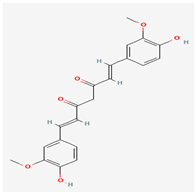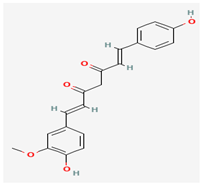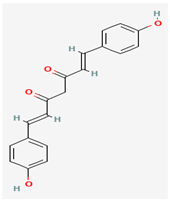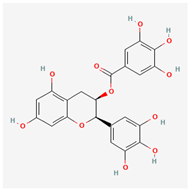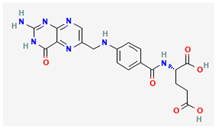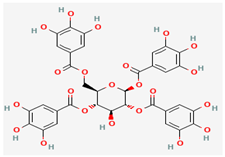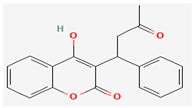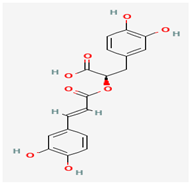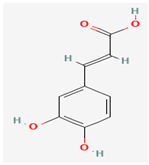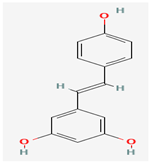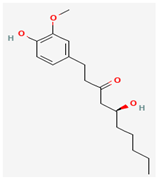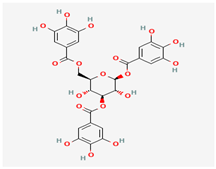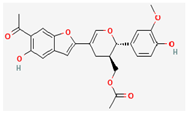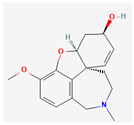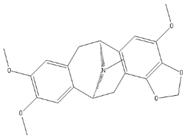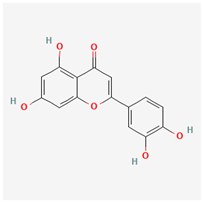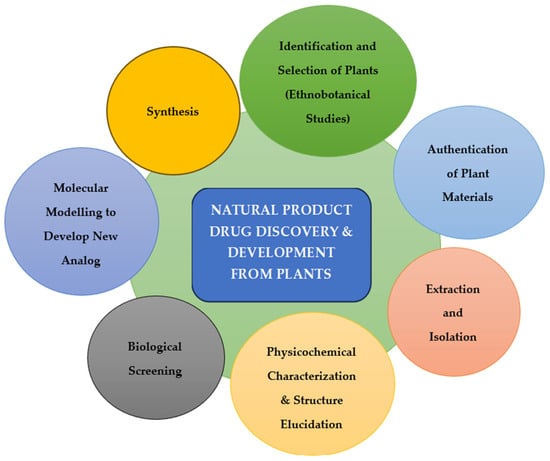Abstract
The global spread of Monkeypox virus (MPXV) has emerged as a major public health concern, with the 2022 outbreak underscoring the urgent need for effective antiviral therapies. Current treatment options are limited because no drugs specifically target Mpox, and existing recommendations rely on repurposed smallpox antivirals that may cause resistance. This highlights the critical need for novel therapeutic agents targeting key viral and host factors involved in MPXV pathogenesis. Medicinal plants provide a rich reservoir of bioactive compounds with potential antiviral activity, particularly in low- and middle-income countries where they play an essential role in healthcare. To address this issue, we conducted a review exploring innovative in silico approaches for natural product-based drug discovery against MPXV. Computational studies identified phytochemicals such as curcumin, punicalagin, rosmarinic acid, and quercitrin with strong affinities for key viral proteins including DNA polymerase, TMPK, DdRp, A42R, MTase, p37, and envelope proteins and favorable pharmacokinetic profiles Despite these promising findings, fragmented biological datasets, viral mutability, and limited in vitro and in vivo validation hinder clinical translation. Our analysis highlights integrating AI-driven virtual screening with experimental validation to accelerate MPXV drug discovery, providing a scalable framework for managing emerging viral threats.
1. Introduction
The zoonotic double-stranded DNA monkeypox virus (MPXV), belonging to the Orthopoxvirus genus of the Poxviridae family [], re-emerged as a significant global health threat during the 2022 outbreak, spreading across more than 110 countries and causing over 84,000 confirmed cases by early 2023. Previously endemic to Central and West Africa, MPXV is now recognized as a global hazard, prompting the World Health Organization (WHO) to declare it a public health emergency [,]. The virus comprises two major clades, Clade I (Central African) and Clade II (West African), which differ in their virulence and case fatality rates. Transmission occurs through direct contact with lesions, respiratory droplets, body fluids, or contaminated surfaces. Recent outbreaks have further underscored the risk of sustained human-to-human spread, particularly within high-risk groups []. Clinically, Mpox manifests with fever, rash, and lymphadenopathy, and in severe cases can progress to life-threatening complications such as encephalitis, pneumonia, and secondary infections [,].
Although global awareness has increased, effective therapeutic options remain limited. Current pharmacological management relies primarily on antivirals originally developed for orthopoxviruses, including tecovirimat (TPOXX®, a VP37/F13L inhibitor) and nucleotide analogs such as cidofovir and brincidofovir, which demonstrate nanomolar to micromolar inhibition in vitro and reduce viral titers in animal models []. However, clinical outcomes have been variable, and their use is constrained by high costs, limited accessibility, and waning orthopoxvirus immunity in the general population []. Vaccines such as ACAM2000 and JYNNEOS provide partial protection but face challenges in coverage and deployment. In addition, several viral proteins, including methyltransferase (MTase) and thymidylate kinase (TMPK), which are critical for immune evasion and replication, remain underexploited as therapeutic targets [,]. Furthermore, the complexity of viral–host interactions and research infrastructure gaps hinder the rapid development of targeted antivirals []. These limitations underscore the urgent need for innovative and cost-effective therapeutic strategies.
Natural product-based drug discovery is gaining momentum as a potential complementary avenue in Mpox management. Emerging in silico and in vitro evidence identifies phytochemicals, such as polyphenols (curcumin, kaempferol, myricetin), bioflavonoids (amentoflavone), phlorotannins (dieckol), and glycosides (theasinensins, kaempferol-O-rhamnosides), with strong binding affinities toward key MPXV targets, including D13, F13/VP37, I7L protease, VP39 MTase, and the DNA polymerase complex []. High-throughput virtual screening of phytochemical libraries such as the IMMPAT, has identified top candidates with docking scores and binding energies comparable to, or even surpassing, reference antivirals. Molecular dynamics (MD) simulations further confirm the stability of these ligand-protein interactions, positioning natural compounds as credible scaffolds for lead optimization []. Several potential inhibitors have been reported, including folic acid, punicalagin, and CID40777874, which target MTase and TMPK with favorable docking and stability profiles []. Nonetheless, many remain at the preclinical stage due to pharmacokinetic limitations such as poor solubility and low bioavailability, as observed with niclosamide []. Strategies including nanocarrier systems, hybrid formulations, and advanced absorption, distribution, metabolism, excretion, toxicity (ADMET)-guided optimization are therefore crucial for translation. Broader classes of natural compounds, such as flavonoids, alkaloids, terpenoids, and marine-derived bioactives, consistently demonstrate in silico antiviral potential but require standardized evaluation and regulatory pathways before clinical adoption [].
Drug repurposing of natural products offers a rapid and cost-effective route to therapeutic development. Notably, traditional Japanese Kampo-derived phytochemicals such as oleanolic, ursolic, and glycyrrhizinic acids show strong affinities and stable MD interactions with MPXV enzymes TMPK and DNA-dependent RNA polymerase (DdRp) [,]. Repurposing FDA-approved natural derivatives with known safety profiles enhances their translational potential, supporting the integration of natural product-based strategies into Mpox drug discovery, especially in resource-limited, outbreak-prone regions. Previous studies on SARS-CoV-2, Ebola, and other viral pathogens support this strategy, showing that combining docking, QSAR, and structural biology approaches can accelerate lead optimization [,,,,]. However, researchers must validate in silico predictions through in vitro and in vivo experiments to resolve limitations like toxicity overestimation. This review therefore explores the potential of natural product–based compounds and recent advances in computational screening, pharmacokinetic prediction, and translational strategies for natural antivirals. By highlighting structural insights, in silico evidence, ADMET-guided validation, and therapeutic development prospects, this study provides a foundation for harnessing natural scaffolds to combat Mpox and related viral threats.
3. In Silico Strategies for Drug Repurposing in Mpox
Structure-based drug design, molecular docking, MD simulations, network pharmacology and AI assisted pipelines have revolutionized Mpox drug repurposing by enabling rapid, cost-effective screening of FDA-approved drugs, phytochemicals, and natural product libraries [,,]. These computational approaches have identified high-affinity inhibitors targeting key MPXV proteins, including DNA-dependent RNA polymerase (E9L), DNA polymerase, TMPK, I7L protease, cysteine proteinases, and the E8L envelope protein [,,]. Beyond conventional docking, AI-driven pipelines integrating deep learning, pharmacophore modeling, and host–virus protein–protein interaction (PPI) networks have identified isoquinoline alkaloids and polyphenolics that inhibit viral replication and modulate host immune pathways []. Importantly, the integration of ADMET filtering and blood–brain barrier (BBB) predictions has streamlined prioritization of leads with favorable pharmacokinetic properties [].
Recent advances have expanded the computational repertoire for MPXV drug discovery. AlphaFolds2-based structural modeling has resolved previously uncharacterized MPXV proteins such as the I7L, M1R, A29, L1R, H3L, E8L, A29, M1R, A35, B6R and L1R, unlocking new docking-ready targets []. Large-scale virtual screening of natural product-derived libraries has also revealed potential leads, such as TCM26463 and SANC00984 against TMPK, which maintained exceptional stability across extended MD trajectories []. Similarly, network-based drug repurposing strategies shortlist 23 low-toxicity candidates out of 268 predicted compounds, highlighting the scalability of integrative computational workflows []. Pharmacokinetic modeling further strengthens translational relevance by identifying candidates with drug-likeness, high gastrointestinal absorption, non-carcinogenicity, and compliance with Lipinski’s rule of five (RO5) []. Coupling these insights with QSAR modeling, PPI networks, and advanced machine learning algorithms (such as random forest, support vector machines, and deep learning) have accelerated hit-to-lead optimization [].
Polypharmacological behavior offers therapeutic breadth and increases the resistance barrier, though it necessitates careful mechanistic validation using proteomics and resistance-selection studies. To further expand candidate space, the Bayesian-based Prediction of Activity Spectra for Substances (PASS) has emerged as a versatile tool, prioritizing antiviral compounds from simple 2D structural inputs []. PASS predicted the antiviral and immunomodulatory potential of flavonoids such as myricetin and kaempferol-O-rhamnosides, later confirmed by docking and MD simulations showing stable binding to MPXV proteins D13 and E8L []. Likewise, PASS highlighted curcumin’s multi-target activity, which was experimentally supported by docking analyses against both viral enzymes and host immune mediators. PASS also prioritizes compounds with drug-like properties, Lipinski’s RO5 compliance, and favorable ADMET profiles, providing a strategic filter to accelerate experimental validation [].
4. Molecular Docking and Binding Affinity
4.1. Identifying Key Monkeypox Viral Proteins as Therapeutic Targets
Structural modeling and validation identify the DNA polymerase holoenzyme and MTase as key enzymes essential for viral DNA synthesis, mRNA capping, and propagation [,,]. TOP1, a conserved enzyme with limited similarity to human homologs, has also been identified as a selective antiviral target, offering opportunities to minimize host off-target toxicity []. Similarly, TMPK, an essential enzyme essential in pyrimidine nucleotide metabolism, has emerged as a potential candidate to disrupt viral DNA synthesis []. Structural analyses of accessory viral proteins, including A42R and envelope proteins (E8, D13, A26), reveal distinct binding pockets and key residues suitable for therapeutic targeting [,,].
Network pharmacology and QSAR modeling expand druggable MPXV targets, notably viral proteinases, cysteine proteases, and the F13 (p37) envelope protein critical for viral assembly and egress []. High-throughput screening of natural product libraries, integrated with advanced MD simulations, has highlighted several stable and the stability and high-affinity binding natural ligands [,]. Importantly, polypharmacology-based strategies such as co-targeting p37, TMPK, and TOP1 are being explored to reduce the likelihood of resistance that often arises with single-target inhibitors [].
Despite this progress, a persistent challenge lies in the drug-likeness limitations of natural products, many of which possess high molecular weights, elevated polarity, or rapid metabolic degradation. Researchers investigate formulation strategies, nanocarriers, prodrugs, semi-synthetic modifications, and topical delivery to enhance bioavailability and pharmacokinetic stability []. As illustrated in Table 2, classes of natural compounds, including flavonoids, alkaloids, terpenoids, and nucleoside analogs, often act through multi-mechanistic pathways, directly inhibiting viral proteins while also modulating host immune responses. This dual mechanism not only broadens the antiviral spectrum but also raises the genetic barrier to resistance []. However, such mechanistic complexity complicates safety profiling and target deconvolution, necessitating integrative approaches such as chemical genetics, resistance selection sequencing, and proteomics-based analyses to elucidate precise modes of action.

Table 2.
Ligand-target interactions for natural product–based compounds in MPXV drug discovery.
Table 2.
Ligand-target interactions for natural product–based compounds in MPXV drug discovery.
| Compound Class | Representative Natural Compounds | Putative MPXV Viral/Host Targets | Proposed Mechanism of Interaction | Evidence Level (Typical) | Translational Notes/Limitations | Refs |
|---|---|---|---|---|---|---|
| Flavonoids | Amentoflavone, Quercetin derivatives, Rutin | Viral proteases (I7L), VP39 methyltransferase, envelope/attachment factors (E8) | Direct binding to catalytic or substrate pockets → inhibition of proteolysis or methylation; also host-kinase modulation (MAPK/NF-κB) | Mostly in silico docking + MD; occasional orthogonal in vitro antiviral assays in related poxviruses | Exhibit high polarity, poor oral bioavailability, and rapid metabolism. Require formulation (nanocarriers) or semi-synthetic optimization. | [,] |
| Alkaloids | Catharanthine, Harmine-type analogs | I7L protease, structural proteins (D13L), host kinases | Occupy protease active sites or allosteric pockets; some show predicted multi-target binding to host factors that virus co-opts | In silico docking/MD with some cross-study consensus; limited phenotypic follow-up | Exhibit potential cytotoxicity at high doses, interact with P-glycoprotein, and cause drug–drug interactions; require cytotoxicity and pharmacokinetic profiling. | [,] |
| Polyphenols/Tannins | Punicalagin, EGCG (epigallocatechin gallate) | Envelope/attachment proteins (E8), entry mediators, viral surface proteins | High-affinity surface binding that can block attachment/entry; may also chelate metal cofactors | In silico + some in vitro viral inhibition (plaque/foci assays) in related viruses | Very polar, large MW → poor systemic exposure; topical or localized delivery may be more practical. | [,] |
| Phenolic acids | Rosmarinic acid, Caffeic acid derivatives | Host signaling hubs (STAT3, NF-κB), viral envelope proteins | Modulate host inflammatory pathways and may indirectly reduce viral replication; predicted binding to envelope proteins | In silico + supporting literature on host modulation (limited direct MPXV phenotypic data) | Anti-inflammatory benefit may reduce immunopathology but not a direct antiviral; ADME optimization needed. | [,] |
| Naphthodianthrones/Photoactive polycycles | Pseudohypericin, Hypericin-like | Multi-target binding (VP39, F13L/VP37, polymerase interfaces) | Predicted stable binding to several viral proteins; photodynamic activity reported for related viruses | In silico docking/MD; known antiviral activity in other viruses (photoactivated) but MPXV data limited | Phototoxicity and formulation challenges; safety concerns require careful evaluation. | [,] |
| Terpenoids/Triterpenes | Betulinic acid derivatives, Ursolic acid analogs | Viral envelope maturation factors, host membrane processes | Disrupt membrane fusion/egress by interacting with viral envelope proteins or host lipid pathways | In silico + some cell-based assays against enveloped viruses | Low water solubility: chemical modification or nanoparticle delivery often required. | [,] |
| Stilbenoids & Resveratrol-type | Resveratrol, Pterostilbene | Host factors (SIRT, NF-κB) and putative weak binding to viral enzymes | Host-directed immunomodulation and modest direct inhibition predicted against replication/minor viral enzymes | In silico + broad antiviral literature; limited direct MPXV phenotypic validation | Rapid metabolism and low plasma exposure; prodrugs or sustained-release formulations may help. | [,] |
| Coumarins & other phenolics | Esculetin, Scopoletin | Viral decapping enzymes (D9), replication-associated proteins | Predicted competitive binding to enzyme active sites, possible synergy with nucleoside analogs | In silico with occasional MD refinement | Moderate drug-likeness; further target deconvolution and ADME profiling needed. | [,] |
4.2. Docking Natural Compounds Against Viral Proteins
Recent studies have demonstrated that molecular docking serves as a powerful in silico tool to predict interactions between natural compounds and Mpox viral proteins. By targeting critical enzymes, phytochemicals can disrupt replication and viral entry. Phytochemical compounds bind strongly, often surpassing standard antivirals in docking performance []. Large-scale screening of COCONUT, SANCDB, IMMPAT, and Traditional Chinese Medicine (TCM) libraries identified antiviral compounds with strong binding to DNA-dependent RNA polymerase, a key viral transcription enzyme [,]. Gallicynoic acid F and H2-Erythro-Neopterin strongly inhibited MPXV proteinase, with binding free energies of −61.42 and −61.09 kcal/mol, respectively, surpassing the benchmark TTP-6171 [,]. Additionally, folic acid and 1,2,4,6-tetragalloylglucose derived from Middle Eastern medicinal plants exhibited robust docking scores and MM/GBSA free energies (−51.87 and −60.61 kcal/mol), with MD simulations confirming their stable interactions with MTase, surpassing the controls (TO1119 at −35.71 kcal/mol and sinefungin at −31.51 kcal/mol) [].
Beyond polymerases and proteases, docking approaches have extended to envelope proteins and accessory proteins, further expanding the therapeutic landscape of natural products. Using state-of-the-art machine learning techniques, high-throughput virtual screening methodology of potent natural compounds on envelope proteins A36R and F13 identified antiviral peptides and polyphenols, including myricetin and demethoxycurcumin, forming stable complexes with binding energies of −6.1 to −9.8 kcal/mol, supported by Glide SP, XP, RMSD and MM/GBSA analyses [,]. Similarly, piperine and kaempferol exhibited binding affinities of −5.57 and −6.98 kcal/mol, respectively, against A42R profilin-like protein. They gave best-pose ligand-binding energies in selected six phytochemicals found in the medicinal plant Ficus religiosa (abundant in India) []. In addition, advanced screening pipelines identified compounds such as comp289, comp295, comp441, and comp449, with binding affinities ranging from −10.79 ± 4.49 to −17.06 ± 2.96 kcal/mol, values comparable to physiological ligands of DNA polymerase []. These findings highlight the versatility of bioactive natural compounds as multi-target inhibitors, capable of modulating diverse viral proteins.
4.3. Evaluating Binding Affinity and Interaction Mechanisms
Computational studies have been indispensable in elucidating the binding affinities and interaction mechanisms of natural compounds against key MPXV proteins. An integrated library of 4103 natural products was screened via Glide docking among which rosmarinic acid, myricitrin, quercitrin, and ofloxacin showed MM/PBSA binding energies down from −9.40 kcal/mol to −16.18 kcal/mol and dissociation constants of 2.16–5.46 μM against viral DNA TOP1 [,]. These compounds are engaged with TOP1 residues (TYR274, LYS167, GLY132, LYS133, etc.). TYR274 was predicted to be a pivotal via hydrogen bonds, hydrophobic contacts, and water-mediated bridges, enhancing complex stability [].
Beyond TOP1, the I7L protease, an essential enzyme in viral maturation, has been highlighted as a particularly potential antiviral target []. Leveraging structural predictions generated and refined by AlphaFold2, researchers have achieved high-confidence models suitable for virtual screening campaigns [,]. Benchmark docking studies with the known inhibitor TTP-6171 (control) revealed multiple stabilizing interactions, including hydrogen bonds and hydrophobic as well as π–π contacts with residues such as Met169, Ser240, Leu323, and Cys328 []. Virtual screening of TCM libraries identified TCM27763 and TCM33057 as stronger inhibitors than TTP-6171, interacting with key residues Trp168, Asn171, Arg196, Ser240, Glu325, Ser326, and Cys328 []. Notably, alnuside B, structurally related to TCM33057, achieved a docking score of −11.62 kcal/mol, forming multiple hydrogen bonds and hydrophobic interactions, indicative of potent suppression of I7L protease activity (Figure 2).
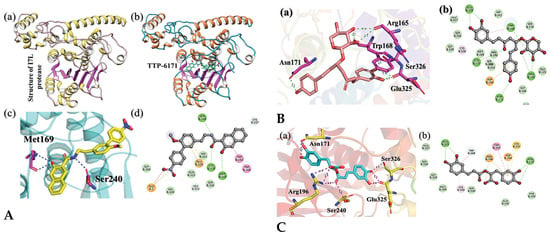
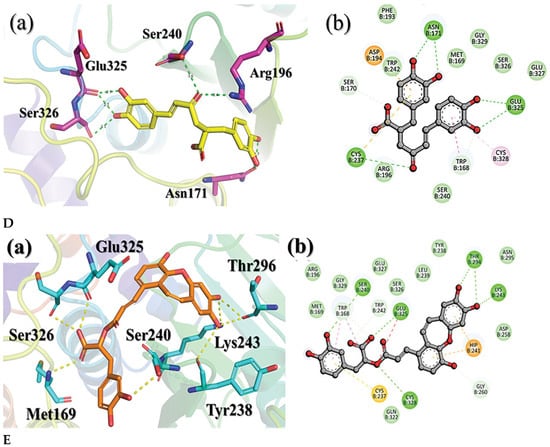
Figure 2.
Redrawn Diagram Binding mode of TCM (34450, 33057,31564,27763) with the active site residues of I7L protease from mpox virus as adapted from the cited source under Creative Commons Attribution 4.0 International License (CC BY 4.0): (A). Structural and binding analysis of I7L protease. (a) modeled 3D structure of I7L, (b) control drug, TTP-6171, bound to the active site of protease (c,d) 3D and 2D interaction pattern of TTP-6171. (D). Binding mode of TCM27763 with the active site residues of I7L protease from mpox. (a) shows the 3D interaction pattern while, (b) shows the 2D interaction pattern of TCM27763. (B). Binding mode of TCM33057 with the active site residues of I7L protease from mpox. (a) shows the 3D interaction pattern while (b) shows the 2D interaction pattern of TCM33057. (C). Binding mode of TCM34450 with the active site residues of I7L protease from mpox. (a) shows the 3D interaction pattern while, (b) shows the 2D interaction pattern of TCM34450. (E). Binding mode of TCM31564 with the active site residues of I7L protease from mpox. (a) shows the 3D interaction pattern while, (b) shows the 2D interaction pattern of TCM31564 [].
5. Pharmacokinetics and ADMET Predictions in MPXV Drug Discovery
5.1. Importance of Drug-Likeness, and ADMET Profiling
Drug-likeness and ADMET properties are critical determinants of a compound’s safety, efficacy, and clinical suitability, forming the cornerstone of early-stage antiviral drug discovery. Studies have demonstrated that natural compounds frequently exhibit favorable pharmacokinetic profiles, reinforcing their potential as potential antiviral agents. Curcumin derivatives showed exceptional ADMET profiles in silico, with the top candidate exhibiting −8.90 kcal/mol binding affinity and docking scores above 6.80 kcal/mol, better than the standard medications, indicating strong stability and bioavailability []. ADMET evaluation of 146 Moringa oleifera phytochemicals identified gossypetin, riboflavin, and ellagic acid as potent DNA polymerase inhibitors (−7.8, −7.6, −7.6 kcal/mol), outperforming Cidofovir (−6.0 kcal/mol) and Brincidofovir (−5.1 kcal/mol) [,]. Virtual screening of 500 compounds against the MPXV-Congo_8-156 protease (explored with bioinformatics tools like PROTPARAM, SOPMA, SWISS-MODEL and PROCHECK) identified five leads (PubChem CIDs: 4061636, 4422538, 3583576, 4856107, and 4800629) alongside the control (Cidofovir). At 100 ns each, confirmed strong structural stability and favorable safety, as confirmed by RMSD, RMSF, and MM-PBSA analyses, highlighting the value of ADMET profiling Further, skin-penetrating natural compounds demonstrated antiviral potential with docking scores between −9.2 and −8.8 kcal/mol, coupled with the absence of predicted AMES toxicity or carcinogenicity in toxicological assessments, underscoring their therapeutic safety []. While, the evaluated log p values for brincidofovir and tecovirimat were higher than those of the other drugs in the QSAR study, complementary QSAR-based analyses also revealed that theaflavin possesses a log p value of 4.77, indicative of high biological activity and favorable drug-like characteristics [].
The integration of ADMET profiling with molecular docking and MD simulations enhances the predictive power of computational pipelines, allowing for more robust validation of candidate suitability. The Random Forest and Ridge regression models demonstrated the strongest correlation between predicted and observed EC50 values. These optimized models were subsequently employed to screen phytochemicals from the Maliaceae family against the MPXV cysteine proteinase. IMPHY010637, a putative MPXV cysteine proteinase inhibitor, maintained stable binding over 100 ns MD simulations, with consistent RMSD values and multiple hydrogen bonds, while exhibiting an acceptable drug-like profile [,]. These results highlight ADMET profiling as essential for translating predictions into validated natural product leads combining safety, efficacy, and drug-likeness for MPXV preclinical development.
5.2. Computational Tools for Assessing Pharmacokinetics Properties of Repurposed Compounds
Predicting the ADMET profiles of repurposed natural compounds is a cornerstone of modern antiviral drug discovery, ensuring early prioritization of candidates with optimal pharmacokinetics and safety. Computational platforms such as SwissADME, pKCSM, and preADMET v2.0 predict key parameters, including solubility, intestinal absorption, BBB permeability, CYP450 inhibition, and toxicity risks such as hepatotoxicity, mutagenicity, and skin sensitization [,]. In silico models enabled high-throughput screening of 5715 phytochemicals from 266 medicinal plants, identifying candidates with strong MPXV binding and favorable pharmacokinetics, validating their translational antiviral potential [].
Recent advances in AI-driven pharmacokinetic modeling have further expanded predictive accuracy and reliability. Platforms such as HelixADMET, which leverage self-supervised learning and multi-task frameworks, now allow extrapolation across chemically diverse scaffolds with minimal experimental training data [,]. Similarly, integrative initiatives like the eTOX project combine cheminformatics, toxicogenomics, and bioinformatics datasets to generate expert systems for early in silico toxicity forecasting, significantly reducing late-stage attrition [,].
Crucially, the integration of ADMET profiling with molecular docking and MD simulations provides a synergistic framework for evaluating compound stability and therapeutic potential under near-physiological conditions. In docking-based screening, top three candidates were selected, which ranked using the ML model. These three compounds were then examined under MD simulation and MM/GBSA-binding free energy analysis against TMPK identified Chlorhexidine HCl with an exceptional MM/GBSA binding free energy of −62.41 kcal/mol, accompanied by high conformational stability (RMSD < 0.3 nm) []. Likewise, flavonoids screened against vaccinia virus TMPK yielded docking scores ranging from −7.0 to −9.3 kcal/mol compared to reference drug (ganciclovir), with subsequent ADMET assessments confirming good oral bioavailability, low toxicity, and potential drug-like profiles [,].
5.3. Case Studies of Natural Compounds with Favorable ADMET Properties
Screening 5715 phytochemicals from 266 IMMPAT plant species identified terchebin, isocinchophyllamine, ruberythric acid, theasinensin F, theasinensin A, and sythiaside as potent inhibitors of viral enzymes E9L and A48R [,]. These compounds not only exhibited positive drug-likeness and predicted pharmacokinetics but also demonstrated superior target selectivity compared to the currently approved antivirals tecovirimat and brincidofovir [,].
Medicinal plant-derived compounds from diverse geographic regions have also yielded encouraging results. Of note, folic acid and 1,2,4,6-tetragalloylglucose, identified from Middle Eastern flora, achieved stronger docking scores and more favorable binding free energies against MPXV MTase than reference inhibitors sinefungin and TO1119 []. Folic acid occupies the MTase catalytic pocket, forms stable hydrogen bonds, and blocks viral mRNA capping, demonstrating natural molecules’ ability to inhibit key viral enzymes [].
Individual case studies further reinforce the therapeutic promise of natural compounds. Curcumin, widely studied for its pleiotropic activity, inhibits DNA polymerase holoenzyme and VP39 MTase while modulating host TNF, NF-κB, and MAPK pathways, providing combined antiviral and immunomodulatory effects [,]. Kaempferol and piperine from Ficus religiosa bind strongly to A42R, with non-mutagenic ADMET profiles and favorable IC50 values of 7.63 μM and 82 μM, they may be suitable lead candidates for developing mpox therapeutic drugs []. In another study, ellagic acid and riboflavin emerged as stable and non-toxic DNA polymerase inhibitors, outperforming brincidofovir and cidofovir in molecular dynamics stability and binding free energy profiles []. These natural compounds with favorable ADMET properties not only rival but may surpass currently approved antivirals.
6. Future Perspectives and Challenges
Phytochemicals represent attractive scaffolds due to their low toxicity, availability, and antiviral potential for MPXV, particularly in low-resource settings. Tools such as molecular docking, MD simulations, and AI-driven interaction models have identified high-affinity ligands and druggable viral targets, but a major gap persists in experimental validation []. Natural compounds such as curcumin and folic acid show strong binding and stability with viral and host proteins, while aurachin A and soraphinol analogs maintain TMPK integrity in silico, but lack in vitro and in vivo validation [].
Despite the rapid advances in computational approaches for antiviral discovery, significant challenges remain in translating MPXV therapies of phytochemical compounds from in silico predictions to clinically validated treatments. The clinical translation is hindered by poor solubility, low membrane permeability, rapid metabolism, and off targets affect that limit bioavailability and therapeutic efficacy. Advances such as nanocarrier-based delivery systems including liposomes, solid lipid nanoparticles, polymeric nanoparticles, prodrug approaches, and semi-synthetic scaffolds optimization have shown promise in overcoming these barriers. Notably, curcumin-loaded nanoparticles significantly improved potency and stability compared to free curcumin, while glycyrrhizin derivatives and betulinic acid analogs demonstrated enhanced absorption and reduced toxicity through rational modification []. Despite these advances, the lack of comprehensive clinical studies, formulation stability data, and pharmacokinetic evaluation continues to restrict clinical application.
Another challenge is the high mutability of MPXV, which may enable variants to evade inhibitors derived from unrelated systems. This underscores the need for real-time genomic surveillance, as AI and machine learning remain limited by incomplete datasets, reducing prediction accuracy and generalizability []. To strengthen translational potential, future efforts should integrate systems biology models, multi-omics datasets (transcriptomics, proteomics, and metabolomics), and high-resolution structural biology to refine target validation and drug design [,].
Computational pipelines generate hypotheses rather than guarantees, as docking, QSAR, and ADMET predictions often overlook off-target effects, metabolic instability, and immune modulation that drive therapeutic failure. This gap emphasizes the need for integrative workflows that combine computational screening with biophysical characterization, cell-based assays, animal models, and pharmacokinetic studies. Moving forward, interdisciplinary collaborations linking computational biology, medicinal chemistry, pharmacology and clinical sciences will be essential. Establishing robust translational pipelines and leveraging advanced formulation technologies will enhance the pharmacological performance of natural product-derived antivirals, supporting their clinical adoption and natural compound-based antiviral discovery applicable to future viral epidemics.
7. Conclusions
The WHO and the Centers for Disease Control and Prevention have recently classified Mpox as a Public Health Emergency of International Concern, underscoring its global health relevance. At present, there are no antiviral therapeutics specifically approved for Mpox, and access to vaccines remains constrained, particularly in endemic and resource-limited regions. In this context, plant-derived bioactive compounds represent a potential reservoir for novel therapeutic development. Computational approaches have enabled the rapid identification of potent inhibitors by elucidating critical interactions between candidate compounds and viral proteins. These natural compounds have good binding properties, good pharmacokinetics, little toxicity, and multifunctional therapeutic potential compared to existing antivirals. Their favorable pharmacokinetics, low toxicity, and multifunctional properties further position them as potential candidates for both therapeutic and prophylactic interventions, particularly in resource-limited settings.
Modeling facilitates the rapid identification of druggable viral targets, enabling high-throughput screening of phytochemicals with demonstrated antiviral and immunomodulatory potential. From a computational biochemistry and natural products perspective, in silico pipelines, ranging from docking to AI-driven pharmacophore modeling deliver true value only when paired with rigorous experimental validation. Computational predictions alone cannot resolve critical translational challenges such as poor availability, limited solubility, rapid metabolic clearance, or off-target toxicities. Potential compounds with favorable docking scores may fail in vivo unless supported by nanocarrier delivery systems, semi-synthetic modifications, or prodrug strategies to enhance stability and systemic exposure. The future of Mpox drug discovery relies on integrating computational screening with pharmacological, biochemical, and clinical pipelines to refine in silico leads into safe, effective therapies. This review underscores the essential role of in silico approaches in modern antiviral development and highlights the untapped potential of natural compounds in bridging the current therapeutic gaps against MPXV. Combining computational modeling with experimental validation and ethnopharmacological insights, global preparedness and response to emerging viral threats can be substantially strengthened.
Author Contributions
Conceptualization—A.G.-A.M.; writing—original draft preparation, A.G.-A.M., writing—review and editing, A.G.-A.M., and D.D.M.; supervision, D.D.M. All authors have read and agreed to the published version of the manuscript.
Funding
This research received no external funding.
Institutional Review Board Statement
Not applicable.
Informed Consent Statement
Not applicable.
Data Availability Statement
Not applicable.
Acknowledgments
Authors acknowledge Samuel Chima Ugbaja, Tambwe Willy Muzumbukilwa, Nonkululeko Avril Mbatha, Mukanda Gedeon Kadima and Nonjabulo Ntombikhona Magwaza for reading and correcting the final version of the manuscript.
Conflicts of Interest
The authors declare no conflicts of interest.
References
- Karagoz, A.; Tombuloglu, H.; Alsaeed, M.; Tombuloglu, G.; AlRubaish, A.A.; Mahmoud, A.; Smajlović, S.; Ćordić, S.; Rabaan, A.A.; Alsuhaimi, E. Monkeypox (mpox) virus: Classification, origin, transmission, genome organization, antiviral drugs, and molecular diagnosis. J. Infect. Public Health 2023, 16, 531–541. [Google Scholar] [CrossRef]
- Begum, J.S.; Ngangom, L.; Semwal, P.; Painuli, S.; Sharma, R.; Gupta, A. Emergence of monkeypox: A worldwide public health crisis. Hum. Cell 2023, 36, 877–893. [Google Scholar] [CrossRef]
- Ebede, S.O.; Orabueze, I.N.; Maduakor, U.C.; Nwafia, I.N.; Ohanu, M.E. Recurrent Mpox: Divergent virulent clades and the urgent need for strategic measures including novel vaccine development to sustain global health security. BMC Infect. Dis. 2025, 25, 536. [Google Scholar] [CrossRef]
- Mohapatra, R.K.; Singh, P.K.; Branda, F.; Mishra, S.; Kutikuppala, L.S.; Suvvari, T.K.; Kandi, V.; Ansari, A.; Desai, D.N.; Alfaresi, M. Transmission dynamics, complications and mitigation strategies of the current mpox outbreak: A comprehensive review with bibliometric study. Rev. Med. Virol. 2024, 34, e2541. [Google Scholar] [CrossRef] [PubMed]
- Mushebenge, A.G.-A.; Mphuthi, D.D. Emerging Insights into Monkeypox: Clinical Features, Epidemiology, Molecular Insights, and Advancements in Management. BioMed 2025, 5, 21. [Google Scholar] [CrossRef]
- Mushebenge, A.G.-A.; Mphuthi, D.D. Deciphering Drug Repurposing Strategies: Antiviral Properties of Candidate Agents Against the Mpox Virus. Sci. Pharm. 2025, 93, 51. [Google Scholar] [CrossRef]
- Lu, J.; Xing, H.; Wang, C.; Tang, M.; Wu, C.; Ye, F.; Yin, L.; Yang, Y.; Tan, W.; Shen, L. Mpox (formerly monkeypox): Pathogenesis, prevention and treatment. Signal Transduct. Target. Ther. 2023, 8, 458. [Google Scholar] [CrossRef] [PubMed]
- Cambaza, E.M. A Review of the Molecular Understanding of the Mpox Virus (MPXV): Genomics, Immune Evasion, and Therapeutic Targets. Zoonotic Dis. 2025, 5, 3. [Google Scholar] [CrossRef]
- Ezat, A.A.; Abduljalil, J.M.; Elghareib, A.M.; Samir, A.; Elfiky, A.A. The discovery of novel antivirals for the treatment of mpox: Is drug repurposing the answer? Expert Opin. Drug Discov. 2023, 18, 551–561. [Google Scholar] [CrossRef]
- Srivastava, V.; Naik, B.; Godara, P.; Das, D.; Mattaparthi, V.S.K.; Prusty, D. Identification of FDA-approved drugs with triple targeting mode of action for the treatment of monkeypox: A high throughput virtual screening study. Mol. Divers. 2024, 28, 1093–1107. [Google Scholar] [CrossRef]
- Mohanto, S.; Faiyazuddin, M.; Gholap, A.D.; Jc, D.; Bhunia, A.; Subbaram, K.; Ahmed, M.G.; Nag, S.; Akhtar, M.S.; Bonilla-Aldana, D.K. Addressing the resurgence of global monkeypox (Mpox) through advanced drug delivery platforms. Travel Med. Infect. Dis. 2023, 56, 102636. [Google Scholar] [CrossRef]
- Nandu, T.G.; Jithesh, K. Natural Product-Based Anti-Viral Agents Against RNA Viruses: An Important Strategy for Pandemic Preparedness. In Drugs from Nature: Targets, Assay Systems and Leads; Springer: Singapore, 2024; pp. 411–440. [Google Scholar]
- Gulati, P.; Chadha, J.; Harjai, K.; Singh, S. Targeting envelope proteins of poxviruses to repurpose phytochemicals against monkeypox: An in silico investigation. Front. Microbiol. 2023, 13, 1073419. [Google Scholar] [CrossRef]
- Vardhan, S.; Sahoo, S.K. Computational studies on searching potential phytochemicals against DNA polymerase activity of the monkeypox virus. J. Tradit. Complement. Med. 2023, 13, 465–478. [Google Scholar] [CrossRef] [PubMed]
- Mushebenge, A.G.-A.; Ugbaja, S.C.; Mbatha, N.A.; Khan, B.R.; Kumalo, H.M. Assessing the potential contribution of in silico studies in discovering drug candidates that interact with various SARS-CoV-2 receptors. Int. J. Mol. Sci. 2023, 24, 15518. [Google Scholar] [CrossRef]
- Mushebenge, A.G.; Ugbaja, S.C.; Mtambo, S.E.; Ntombela, T.; Metu, J.I.; Babayemi, O.; Chima, J.I.; Appiah-Kubi, P.; Odugbemi, A.I.; Ntuli, M.L. Unveiling the Inhibitory Potentials of Peptidomimetic Azanitriles and Pyridyl Esters towards SARS-CoV-2 Main Protease: A Molecular Modelling Investigation. Molecules 2023, 28, 2641. [Google Scholar] [CrossRef]
- Morais, G.C.d.F.; de Souza Sena, C.P.; Silva, G.V.R.; Alves, G.B.; Vieira, D.S.; Akash, S.; Aktaruzzaman, M.; Al-Dies, A.-A.M.; Fulco, U.L.; Oliveira, J.I.N. Comprehensive evaluation of potential EBOV inhibitors using advanced molecular modeling techniques: Implications for anti-Ebola therapeutics and rational drug design. Future J. Pharm. Sci. 2025, 11, 145. [Google Scholar] [CrossRef]
- Siddika, A. Computational Investigation of nsP2 Inhibitors for Chikungunya Virus Treatment: Advancing Therapeutic Strategies Against Viral Infections; BRAC University: Dhaka, Bangladesh, 2025. [Google Scholar]
- Ndayambaje, M.; Munyeshyaka, E.; Dieumerci, O.; Habyarimana, T.; Ndishimye, P.; Naya, A.; Oudghiri, M. Plant-derived molecules in monkeypox management: Insight and alternative therapeutic strategies. Beni-Suef Univ. J. Basic Appl. Sci. 2025, 14, 17. [Google Scholar] [CrossRef]
- Maurya, V.K.; Kumar, S.; Maurya, S.; Ansari, S.; Paweska, J.T.; Abdel-Moneim, A.S.; Saxena, S.K. Structure-based drug designing for potential antiviral activity of selected natural product against Monkeypox (Mpox) virus and its host targets. VirusDisease 2024, 35, 589–608. [Google Scholar] [CrossRef] [PubMed]
- Ridho, F.M.; Nur’aini, A.D.; Al Atsariyah, H.; Syachputra, A.J.; Wardana, W.E.; Nurhuda, A. Curcumin and its derivatives as potential antiviral candidates against monkeypox (mpox): A review of computational studies. Ars Pharm. 2025, 66, 225–232. [Google Scholar] [CrossRef]
- Ali, S.I.; Salama, A. Natural immunomodulatory agents as a complementary therapy for poxviruses. In Poxviruses; Springer: Cham, Switzerland, 2024; pp. 337–354. [Google Scholar] [CrossRef]
- Priya, S.P.; Amalraj, S.; Padmanabhan, V.; Rahman, M.M.; Chaitanya, N.C.; Hashim, N.T.; Prabhu, S.; Ayyanar, M.; Gurav, S.; Ceasar, S.A.; et al. Evaluating the Antiviral Potential of Polyherbal Formulation (Kabasura kudineer) Against Monkeypox Virus: Targeting E5, Poxin, and DNA Polymerase Through Multifaceted Drug Discovery Approaches. Life 2025, 15, 771. [Google Scholar] [CrossRef]
- Ashley, C.N.; Broni, E.; Wood, C.M.; Okuneye, T.; Ojukwu, M.T.; Dong, Q.; Gallagher, C.; Miller, W.A., 3rd. Identifying potential monkeypox virus inhibitors: An in silico study targeting the A42R protein. Front. Cell. Infect. Microbiol. 2024, 14, 1351737. [Google Scholar] [CrossRef] [PubMed]
- Khan, A.; Adil, S.; Qudsia, H.A.; Waheed, Y.; Alshabrmi, F.M.; Wei, D.-Q. Structure-based design of promising natural products to inhibit thymidylate kinase from Monkeypox virus and validation using free energy calculations. Comput. Biol. Med. 2023, 158, 106797. [Google Scholar] [CrossRef] [PubMed]
- Singh, V.; Dwivedi, S.; Agrawal, R.; Sadashiv; Fatima, G.; Abidi, A. The human Monkeypox virus and host immunity: Emerging diagnostic and therapeutic challenges. Infect. Disord.-Drug Targets 2025, 25, E18715265309361. [Google Scholar] [CrossRef]
- Dubey, A.; Alawi, M.M.; Alandijany, T.A.; Alsaady, I.M.; Altwaim, S.A.; Sahoo, A.K.; Dwivedi, V.D.; Azhar, E.I. Exploration of microbially derived natural compounds against monkeypox virus as viral core cysteine proteinase inhibitors. Viruses 2023, 15, 251. [Google Scholar] [CrossRef]
- Banik, A.; Ahmed, S.R.; Shahid, S.B.; Ahmed, T.; Tamanna, H.K.; Marma, H. Therapeutic Promises of Plant Metabolites against Monkeypox Virus: An In Silico Study. Adv. Virol. 2023, 2023, 9919776. [Google Scholar] [CrossRef]
- Mohapatra, R.K.; Mahal, A.; Mohapatra, P.K.; Sarangi, A.K.; Mishra, S.; Alsuwat, M.A.; Alshehri, N.N.; Abdelkhalig, S.M.; Garout, M.; Aljeldah, M.; et al. Structure-based discovery of F. religiosa phytochemicals as potential inhibitors against Monkeypox (mpox) viral protein. J. Biosaf. Biosecurity 2024, 6, 157–169. [Google Scholar] [CrossRef]
- Akash, S.; Hossain, A.; Hossain, M.S.; Rahman, M.M.; Ahmed, M.Z.; Ali, N.; Valis, M.; Kuca, K.; Sharma, R. Anti-viral drug discovery against monkeypox and smallpox infection by natural curcumin derivatives: A Computational drug design approach. Front. Cell. Infect. Microbiol. 2023, 13, 1157627. [Google Scholar]
- Boudou, F.; Belakredar, A.; Keziz, A.; Aissani, L.; Alsaeedi, H.; Cronu, D.; Bechelany, M.; Barhoum, A. Therapeutic potential of Curcuma longa against monkeypox: Antioxidant, anti-inflammatory, and computational insights. Front. Chem. 2025, 12, 1509913. [Google Scholar] [CrossRef]
- Chojnacka, K.; Skrzypczak, D.; Izydorczyk, G.; Mikula, K.; Szopa, D.; Witek-Krowiak, A. Antiviral properties of polyphenols from plants. Foods 2021, 10, 2277. [Google Scholar] [CrossRef]
- Capasso, L.; De Masi, L.; Sirignano, C.; Maresca, V.; Basile, A.; Nebbioso, A.; Rigano, D.; Bontempo, P. Epigallocatechin Gallate (EGCG): Pharmacological Properties, Biological Activities and Therapeutic Potential. Molecules 2025, 30, 654. [Google Scholar] [CrossRef]
- Hashim, H.O.; Al-Shuhaib, J.M.B.; Mohammed, M.K.; Al-Shuhaib, M.B.S. Targeting Monkeypox Virus Methyltransferase: Virtual Screening of Natural Compounds from Middle-Eastern Medicinal Plants. Mol. Biotechnol. 2024, 67, 3194–3216. [Google Scholar] [CrossRef]
- Tiwari, A.; Mahadik, K.R.; Gabhe, S.Y. Piperine: A comprehensive review of methods of isolation, purification, and biological properties. Med. Drug Discov. 2020, 7, 100027. [Google Scholar] [CrossRef]
- Nadeem, M.; Imran, M.; Aslam Gondal, T.; Imran, A.; Shahbaz, M.; Muhammad Amir, R.; Wasim Sajid, M.; Batool Qaisrani, T.; Atif, M.; Hussain, G.; et al. Therapeutic Potential of Rosmarinic Acid: A Comprehensive Review. Appl. Sci. 2019, 9, 3139. [Google Scholar] [CrossRef]
- Langland, J.; Jacobs, B.; Wagner, C.E.; Ruiz, G.; Cahill, T.M. Antiviral activity of metal chelates of caffeic acid and similar compounds towards herpes simplex, VSV-Ebola pseudotyped and vaccinia viruses. Antiviral. Res. 2018, 160, 143–150. [Google Scholar] [CrossRef] [PubMed]
- Hu, X.; An, S.; Chu, J.; Liang, B.; Liao, Y.; Jiang, J.; Lin, Y.; Ye, L.; Liang, H. Potential inhibitors of monkeypox virus revealed by molecular modeling approach to viral DNA topoisomerase I. Molecules 2023, 28, 1444. [Google Scholar] [CrossRef]
- Adepoju, O.A.; Danazumi, A.U.; Dibba, L.B.S.; Ibrahim, B.; Gital, S.I.; Ibrahim, J.G.; Jibrailu, M.L.; Balogun, E.O. Computational interrogation of natural compounds identified resveratrol-3-O-D-glucopyranoside as a potential inhibitor of essential monkeypox virus proteins. Intell. Med. 2025, 5, 5–13. [Google Scholar] [CrossRef]
- Rout, M.; Mishra, S.; Dey, S.; Singh, M.K.; Dehury, B.; Pati, S. Exploiting the potential of natural polyphenols as antivirals against monkeypox envelope protein F13 using machine learning and all-atoms MD simulations. Comput. Biol. Med. 2023, 162, 107116. [Google Scholar] [CrossRef]
- Shaukat, M.N.; Nazir, A.; Fallico, B. Ginger Bioactives: A Comprehensive Review of Health Benefits and Potential Food Applications. Antioxidants 2023, 12, 2015. [Google Scholar] [CrossRef]
- Sharma, S.; Shukla, M.K.; Sharma, K.C.; Tirath; Kumar, L.; Anal, J.M.H.; Upadhyay, S.K.; Bhattacharyya, S.; Kumar, D. Revisiting the therapeutic potential of gingerols against different pharmacological activities. Naunyn Schmiedeberg’s Arch. Pharmacol. 2023, 396, 633–647. [Google Scholar] [CrossRef] [PubMed]
- Prichard, M.N.; Kern, E.R. Orthopoxvirus targets for the development of new antiviral agents. Antivir. Res. 2012, 94, 111–125. [Google Scholar] [CrossRef]
- Pourhajibagher, M.; Bahador, A. Virtual screening and computational simulation analysis of antimicrobial photodynamic therapy using propolis-benzofuran A to control of Monkeypox. Photodiagnosis Photodyn. Ther. 2023, 41, 103208. [Google Scholar] [CrossRef]
- Ghate, S.D.; Pinto, L.; Alva, S.; Srinivasa, M.G.; Vangala, R.K.; Naik, P.; Revanasiddappa, B.; Rao, R.S.P. In silico identification of potential phytochemical inhibitors for mpox virus: Molecular docking, MD simulation, and ADMET studies. Mol. Divers. 2024, 28, 4067–4086. [Google Scholar] [CrossRef] [PubMed]
- Selvaraj, K.V.; Prabha, T.; Karthikeyan, J.; Rani, C.I.; Vethamoni, P.I.; Bharathi, A. Harnessing nature’s arsenal: A comprehensive review of phytomedicine approaches in Monkeypox treatment. Ann. Phytomedicine 2024, 13, 23–32. [Google Scholar] [CrossRef]
- Zakaryan, H.; Arabyan, E.; Oo, A.; Zandi, K. Flavonoids: Promising natural compounds against viral infections. Arch. Virol. 2017, 162, 2539–2551. [Google Scholar] [CrossRef]
- Di Petrillo, A.; Orrù, G.; Fais, A.; Fantini, M.C. Quercetin and its derivates as antiviral potentials: A comprehensive review. Phytother. Res. 2022, 36, 266–278. [Google Scholar] [CrossRef]
- Nguyen, T.L.A.; Bhattacharya, D. Antimicrobial Activity of Quercetin: An Approach to Its Mechanistic Principle. Molecules 2022, 27, 2494. [Google Scholar] [CrossRef] [PubMed]
- Goswami, P.; Fakola, E.G.; Ghosh, S.; Ghosh, S.; Das, S. From phytomedicine to conventional drug research, to look for new drug molecule against monkey pox virus; a molecular docking, virtual screening and ADME analysis. Silico Pharmacol. 2025, 13, 20. [Google Scholar] [CrossRef] [PubMed]
- Pandey, A.; Israr, J.; Pandey, J.; Misra, S. Current Approaches and Implications in Discovery of Novel Bioactive Products from Microbial Sources. Curr. Microbiol. 2025, 82, 258. [Google Scholar] [CrossRef]
- Cech, N.B.; Oberlies, N.H. From plant to cancer drug: Lessons learned from the discovery of taxol. Nat. Prod. Rep. 2023, 40, 1153–1157. [Google Scholar] [CrossRef]
- Dsouza, L.; Pant, A.; Offei, S.; Priyamvada, L.; Pope, B.; Satheshkumar, P.S.; Wang, Z.; Yang, Z. Antiviral activities of two nucleos(t)ide analogs against vaccinia, mpox, and cowpox viruses in primary human fibroblasts. Antivir. Res. 2023, 216, 105651. [Google Scholar] [CrossRef]
- Ahmad, F.; Sachdeva, A.; Sah, B.K.; Kumar, A.; Kumar, R.; Seksaria, B. A review of herbal therapeutics for the prevention and management of poxvirus infections. Arch. Microbiol. 2025, 207, 186. [Google Scholar] [CrossRef]
- Sharifan, A. Natural Compounds against Mpox: Mapping Evidence and Identifying Gaps. Planta Med. 2025, 91, 271–273. [Google Scholar] [CrossRef]
- Grajales, D.B.; Kar, S. Exploring Monkeypox: Prospects for therapeutics through computational-aided drug discovery. Mol. Divers. 2023, 28, 3497–3521. [Google Scholar] [CrossRef] [PubMed]
- Najmi, A.; Javed, S.A.; Al Bratty, M.; Alhazmi, H.A. Modern Approaches in the Discovery and Development of Plant-Based Natural Products and Their Analogues as Potential Therapeutic Agents. Molecules 2022, 27, 349. [Google Scholar] [CrossRef] [PubMed]
- Shaker, B.; Ahmad, S.; Lee, J.; Jung, C.; Na, D. In silico methods and tools for drug discovery. Comput. Biol. Med. 2021, 137, 104851. [Google Scholar] [CrossRef]
- Shrivastava, R.; Modi, G.; Satpathy, P.S.; Bandyopadhyay, S.; Kumar, Y.; Yadav, I. Natural Products Revolutionizing and Innovative Drug Discovery and Development Strategies: Healthcare Challenges and Future Perspectives. J. Appl. Bioanal. 2024, 10, 20–38. [Google Scholar]
- Moore, M.J.; Rathish, B.; Zahra, F. Mpox (Monkeypox); StatPearls Publishing: Treasure Island, FL, USA, 2023. [Google Scholar]
- Montenegro-Landívar, M.F.; Tapia-Quirós, P.; Vecino, X.; Reig, M.; Valderrama, C.; Granados, M.; Cortina, J.L.; Saurina, J. Polyphenols and their potential role to fight viral diseases: An overview. Sci. Total Environ. 2021, 801, 149719. [Google Scholar] [CrossRef] [PubMed]
- Abduljalil, J.M.; Elfiky, A.A.; Elgohary, A.M. Exploration of natural compounds against the human mpox virus DNA-dependent RNA polymerase in silico. J. Infect. Public Health 2023, 16, 996–1003. [Google Scholar] [CrossRef]
- Aydemir, D.; Ulusu, N.N. The possible importance of the antioxidants and oxidative stress metabolism in the emerging monkeypox disease: An opinion paper. Front. Public Health 2022, 10, 1001666. [Google Scholar] [CrossRef]
- Rajak, P.; Ganguly, A.; Dey, S.; Sen, K. In silico targeting of pox virus proteins to repurpose triterpenes against monkeypox infection. Comput. Struct. Biotechnol. Rep. 2025, 2, 100027. [Google Scholar] [CrossRef]
- Winkler, D.A. Computational repurposing of drugs for viral diseases and current and future pandemics. J. Math. Chem. 2024, 62, 2844–2879. [Google Scholar] [CrossRef]
- Khan, S.; Ray, I. Bioactive Phytochemicals for Human Monkeypox Outbreak. Asian J. Res. Infect. Dis. 2025, 16, 24–43. [Google Scholar] [CrossRef]
- Trepte, P.; Secker, C.; Olivet, J.; Blavier, J.; Kostova, S.; Maseko, S.B.; Minia, I.; Silva Ramos, E.; Cassonnet, P.; Golusik, S.; et al. AI-guided pipeline for protein-protein interaction drug discovery identifies a SARS-CoV-2 inhibitor. Mol. Syst. Biol. 2024, 20, 428–457. [Google Scholar] [CrossRef]
- Pathan, I.; Raza, A.; Sahu, A.; Joshi, M.; Sahu, Y.; Patil, Y.; Raza, M.A.; Ajazuddin. Revolutionizing pharmacology: AI-powered approaches in molecular modeling and ADMET prediction. Med. Drug Discov. 2025, 28, 100223. [Google Scholar] [CrossRef]
- Kushwaha, J.M.; Rani, M.S.S.; Singh, S. Targeting monkeypox virus (MPXV): Strategies for molecular docking studies on protein inhibition. Virus Genes 2025, 61, 523–534. [Google Scholar] [CrossRef]
- Mishra, S.K.; Chandra, A.; Mitra, N.; Krishna, N.; Singh, N.; Akash, S.; Jardan, Y.A.B.; Bourhia, M.; Georrge, J.J. Exploring the Dynamics of Asparagus racemosus Phytochemicals as Dual Target Inhibitors of Monkeypox Virus. Curr. Med. Chem. 2025, 32, 8678–8700. [Google Scholar] [CrossRef] [PubMed]
- Al Mashud, M.A.; Kumer, A.; Mukerjee, N.; Chandro, A.; Maitra, S.; Chakma, U.; Dey, A.; Akash, S.; Alexiou, A.; Khan, A.A.; et al. Mechanistic inhibition of Monkeypox and Marburg virus infection by O-rhamnosides and Kaempferol-o-rhamnosides derivatives: A new-fangled computational approach. Front. Cell. Infect. Microbiol. 2023, 13, 1188763. [Google Scholar] [CrossRef]
- Athar, M.; Sona, A.N.; Bekono, B.D.; Ntie-Kang, F. Fundamental physical and chemical concepts behind “drug-likeness” and “natural product-likeness”. Phys. Sci. Rev. 2019, 4, 20180101. [Google Scholar] [CrossRef]
- Chen, A.; Fang, N.; Zhang, Z.; Wen, Y.; Shen, Y.; Zhang, Y.; Zhang, L.; Zhao, G.; Ding, J.; Li, J. Structural basis of the monkeypox virus mRNA cap N7 methyltransferase complex. Emerg. Microbes Infect. 2024, 13, 2369193. [Google Scholar] [CrossRef] [PubMed]
- Peng, Q.; Xie, Y.; Kuai, L.; Wang, H.; Qi, J.; Gao, G.F.; Shi, Y. Structure of monkeypox virus DNA polymerase holoenzyme. Science 2023, 379, 100–105. [Google Scholar] [CrossRef]
- Grifoni, L.; Vanti, G.; Donato, R.; Sacco, C.; Bilia, A.R. Promising Nanocarriers to Enhance Solubility and Bioavailability of Cannabidiol for a Plethora of Therapeutic Opportunities. Molecules 2022, 27, 6070. [Google Scholar] [CrossRef]
- Adeosun, W.B.; Loots, D.T. Medicinal Plants against Viral Infections: A Review of Metabolomics Evidence for the Antiviral Properties and Potentials in Plant Sources. Viruses 2024, 16, 218. [Google Scholar] [CrossRef]
- Balasundar, A.; Parsanathan, R. In Silico Screening of Phenylpropanoid and Polyketide Phytochemicals as Potential Inhibitors of Mpox Viral Proteins. Exon 2025, 2, 132–151. [Google Scholar] [CrossRef]
- Astakala, R.V.; Preet, G.; Haj Hasan, A.; Desai, R.; Alfurayh, M.; Ebel, R.; Jaspars, M. Computational repurposing of polyphenols for anti-Mpoxviral activity. Silico Pharmacol. 2025, 13, 65. [Google Scholar] [CrossRef]
- Alandijany, T.A.; El-Daly, M.M.; Tolah, A.M.; Bajrai, L.H.; Khateb, A.M.; Kumar, G.S.; Dubey, A.; Dwivedi, V.D.; Azhar, E.I. A multi-targeted computational drug discovery approach for repurposing tetracyclines against monkeypox virus. Sci. Rep. 2023, 13, 14570. [Google Scholar] [CrossRef]
- Duta-Bratu, C.G.; Nitulescu, G.M.; Mihai, D.P.; Olaru, O.T. Resveratrol and Other Natural Oligomeric Stilbenoid Compounds and Their Therapeutic Applications. Plants 2023, 12, 2935. [Google Scholar] [CrossRef]
- Khan, A.; Shahab, M.; Nasir, F.; Waheed, Y.; Alshammari, A.; Mohammad, A.; Zichen, G.; Li, R.; Wei, D. Exploring the Traditional Chinese Medicine (TCM) database chemical space to target I7L protease from monkeypox virus using molecular screening and simulation approaches. SAR QSAR Environ. Res. 2023, 34, 689–708. [Google Scholar] [CrossRef]
- Shah, B.M.; Modi, P. Breaking Barriers: Current Advances and Future Directions in Mpox Therapy. Curr. Drug Targets 2024, 25, 62–76. [Google Scholar] [CrossRef]
- Miah, M.M.; Tabassum, N.; Afroj Zinnia, M.; Islam, A.B.M.M.K. Drug and anti-viral peptide design to inhibit the monkeypox virus by restricting A36R protein. Bioinform. Biol. Insights 2022, 16, 11779322221141164. [Google Scholar] [CrossRef] [PubMed]
- Chen, C.; Chen, Y.; Ye, Z.; Ali, A.; Yao, S. Bioactive Deep Eutectic Solvent-Involved Sprayable Versatile Hydrogel for Monkeypox Virus Lesions Treatment. ACS Appl. Mater. Interfaces 2024, 17, 2148–2168. [Google Scholar] [CrossRef] [PubMed]
- Dodaro, A.; Pavan, M.; Moro, S. Targeting the I7L protease: A rational design for anti-monkeypox drugs? Int. J. Mol. Sci. 2023, 24, 7119. [Google Scholar] [CrossRef]
- Yousaf, M.A.; Basheera, S.; Sivanandan, S. Inhibition of Monkeypox Virus DNA polymerase using Moringa oleifera Phytochemicals: Computational studies of drug-Likeness, molecular docking, molecular dynamics simulation and density functional theory. Indian J. Microbiol. 2024, 64, 1057–1074. [Google Scholar] [CrossRef] [PubMed]
- Raen, R.; Islam, M.M.; Islam, R.; Islam, M.R.; Jarin, T. Functional characterization and structural prediction of hypothetical proteins in monkeypox virus and identification of potential inhibitors. Mol. Divers. 2025, 29, 1589–1617. [Google Scholar] [CrossRef]
- Mohapatra, R.K.; Mahal, A.; Ansari, A.; Kumar, M.; Guru, J.P.; Sarangi, A.K.; Abdou, A.; Mishra, S.; Aljeldah, M.; AlShehail, B.M. Comparison of the binding energies of approved mpox drugs and phytochemicals through molecular docking, molecular dynamics simulation, and ADMET studies: An in silico approach. J. Biosaf. Biosecurity 2023, 5, 118–132. [Google Scholar] [CrossRef]
- Rabaan, A.A.; Halwani, M.A.; Alshehri, A.A.; Al-Subaie, M.F.; Almansour, Z.H.; AlShehail, B.M.; Alotaibi, N.; Khamis, F.; Al Kaabi, N.A.; Alsomali, G. Bioprospecting of Meliaceae family phytomolecules for the treatment of monkeypox virus infection: A QSAR modeling and MD simulation approach. J. Biomol. Struct. Dyn. 2025, 43, 2277–2299. [Google Scholar] [CrossRef]
- Imran, M.; Abida; Alotaibi, N.M.; Thabet, H.K.; Alruwaili, J.A.; Eltaib, L.; Alshehri, A.; Alsaiari, A.A.; Kamal, M.; Alshammari, A.M.A. Repurposing anti-dengue compounds against monkeypox virus targeting core cysteine protease. Biomedicines 2023, 11, 2025. [Google Scholar] [CrossRef]
- Dutt, M.; Kumar, A.; Rout, M.; Dehury, B.; Martinez, G.; Ndishimye, P.; Kelvin, A.A.; Kelvin, D.J. Drug repurposing for Mpox: Discovery of small molecules as potential inhibitors against DNA-dependent RNA polymerase using molecular modeling approach. J. Cell. Biochem. 2023, 124, 701–715. [Google Scholar] [CrossRef]
- Zhang, S.; Yan, Z.; Huang, Y.; Liu, L.; He, D.; Wang, W.; Fang, X.; Zhang, X.; Wang, F.; Wu, H.; et al. HelixADMET: A robust and endpoint extensible ADMET system incorporating self-supervised knowledge transfer. Bioinformatics 2022, 38, 3444–3453. [Google Scholar] [CrossRef] [PubMed]
- Yang, X.; Wang, Y.; Lin, Y.; Zhang, M.; Liu, O.; Shuai, J.; Zhao, Q. A Multi-Task Self-Supervised Strategy for Predicting Molecular Properties and FGFR1 Inhibitors. Adv. Sci. 2025, 12, e2412987. [Google Scholar] [CrossRef] [PubMed]
- Paul, D.; Saha, S.; Basu, S.; Chakraborti, T. Computational analysis of pathogen-host interactome for fast and low-risk in-silico drug repurposing in emerging viral threats like Mpox. Sci. Rep. 2024, 14, 18736. [Google Scholar] [CrossRef] [PubMed]
- Asif, S.; Zhao, M.; Li, Y.; Tang, F.; Ur Rehman Khan, S.; Zhu, Y. AI-based approaches for the diagnosis of Mpox: Challenges and future prospects. Arch. Comput. Methods Eng. 2024, 31, 3585–3617. [Google Scholar] [CrossRef]
- Abdizadeh, T. Identification of novel potential inhibitors of monkeypox virus thymidine kinase using molecular docking, molecular dynamics simulation and MM/PBSA methods. Mol. Divers. 2024, 28, 2513–2546. [Google Scholar] [CrossRef] [PubMed]
- Wang, D.-P.; Zhao, R.; Wang, H.-F.; Wang, M.-Y.; Hu, W.-S.; Lin, M.-M.; Shu, W.; Sun, Y.-J.; Cao, J.-M.; Cui, W. Crystal structure of mRNA cap (guanine-N7) methyltransferase E12 subunit from monkeypox virus and discovery of its inhibitors. Int. J. Biol. Macromol. 2023, 253, 127565. [Google Scholar] [CrossRef]
- Arasu, M.V.; Vijayaragavan, P.; Purushothaman, S.; Rathi, M.A.; Al-Dhabi, N.A.; Gopalakrishnan, V.K.; Choi, K.C.; Ilavenil, S. Molecular docking of monkeypox (mpox) virus proteinase with FDA approved lead molecules. J. Infect. Public Health 2023, 16, 784–791. [Google Scholar] [CrossRef] [PubMed]
- Ali, Y.; Khan, A.A.; Alanazi, A.M.; Abdikakharovich, S.A.; Shah, J.A.; Ren, Z.-G.; Khattak, S. Identification of the myxobacterial secondary metabolites Aurachin A and Soraphinol A as promising inhibitors of thymidylate kinase of the Monkeypox virus. Mol. Divers. 2024, 28, 3349–3362. [Google Scholar] [CrossRef]
- Tupally, K.R.; Seal, P.; Pandey, P.; Lohman, R.J.; Smith, S.; Ouyang, D.; Parekh, H. Integration of Dendrimer-Based Delivery Technologies with Computational Pharmaceutics and Their Potential in the Era of Nanomedicine. Explor. Comput. Pharm. AI Model. Pharma 4.0 2024, 12, 328–378. [Google Scholar]
- Al-Sulaiti, H.; Almaliti, J.; Naman, C.B.; Al Thani, A.A.; Yassine, H.M. Metabolomics approaches for the diagnosis, treatment, and better disease management of viral infections. Metabolites 2023, 13, 948. [Google Scholar] [CrossRef]
- El-kenawy, E.-S.M. Leveraging Advanced Machine Learning for Pioneering Monkeypox Diagnosis: A New Paradigm in Infectious Disease Detection. Metaheuristic Optim. Rev. 2024, 1, 1–16. [Google Scholar]
Disclaimer/Publisher’s Note: The statements, opinions and data contained in all publications are solely those of the individual author(s) and contributor(s) and not of MDPI and/or the editor(s). MDPI and/or the editor(s) disclaim responsibility for any injury to people or property resulting from any ideas, methods, instructions or products referred to in the content. |
© 2025 by the authors. Licensee MDPI, Basel, Switzerland. This article is an open access article distributed under the terms and conditions of the Creative Commons Attribution (CC BY) license (https://creativecommons.org/licenses/by/4.0/).
